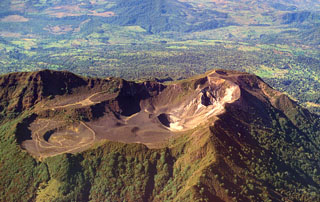Report on Turrialba (Costa Rica) — 1 February-7 February 2017
Smithsonian Institution / US Geological Survey
Weekly Volcanic Activity Report, 1 February-7 February 2017
Managing Editor: Sally Sennert.
Please cite this report as:
Global Volcanism Program, 2017. Report on Turrialba (Costa Rica) (Sennert, S, ed.). Weekly Volcanic Activity Report, 1 February-7 February 2017. Smithsonian Institution and US Geological Survey.
Turrialba
Costa Rica
10.025°N, 83.767°W; summit elev. 3340 m
All times are local (unless otherwise noted)
On 1 February OVSICORI-UNA reported that since 27 January the seismic network at Turrialba recorded variable-amplitude, discontinuous tremor indicative of moving pressurized volcanic fluid. Passive emissions of ash were observed during 1-2 February, rising as high as 500 m above the crater. Ashfall was reported in Desamparados, Calle Blancos, and Tres Ríos, and a sulfur odor was noted in San Pablo Heredia. An eruption at 0900 on 4 February generated an ash plume that rose 300 m and drifted W. Almost continuous ash emissions rose at most 500 above the crater during 4-5 February and drifted WSW. Variable-amplitude tremor continued to be recorded.
Geological Summary. Turrialba, the easternmost of Costa Rica's Holocene volcanoes, is a large vegetated basaltic-to-dacitic stratovolcano located across a broad saddle NE of Irazú volcano overlooking the city of Cartago. The massive edifice covers an area of 500 km2. Three well-defined craters occur at the upper SW end of a broad 800 x 2200 m summit depression that is breached to the NE. Most activity originated from the summit vent complex, but two pyroclastic cones are located on the SW flank. Five major explosive eruptions have occurred during the past 3500 years. A series of explosive eruptions during the 19th century were sometimes accompanied by pyroclastic flows. Fumarolic activity continues at the central and SW summit craters.
Source: Observatorio Vulcanologico y Sismologico de Costa Rica-Universidad Nacional (OVSICORI-UNA)

